 18 min
18 min16 Effortless eCommerce Link Building Strategies
Discover how to develop and boost organic traffic and establish a robust link profile with these eCommerce link building strategies.
 Written by
Written by

Nick Brogden leads the company as Founder and CEO of Earned Media, acting as Chief SEO Strategist and primary client contact. Nick provides clients with personalised and expert SEO guidance that aligns with the industry’s best practices and has over 12 years of hands-on SEO experience. Have any SEO questions you’d like to ask Nick? Drop him an email at nick@earnedmedia.com.au.
 Edited by
Edited by

Tara Tyrrell is the Chief Editor for Earned Media’s blog and Earned Media’s clients. Tara contributes by refining, meticulously reviewing, and fact-checking content to ensure it adheres to the highest standards within the industry.
 Reviewed by
Reviewed by

Harry Gibson is a Content Marketing Associate at Earned Media with a passion for creating engaging and informative content that drives results. He has a keen eye for detail and a knack for crafting compelling content that resonates with readers. Have any content and SEO questions you’d like to ask Harry? Drop him an email at harry@earnedmedia.com.au
19 min read
Published: November 28, 2022. 8:25 PM AEST+10
Last updated on: August 19th, 2025
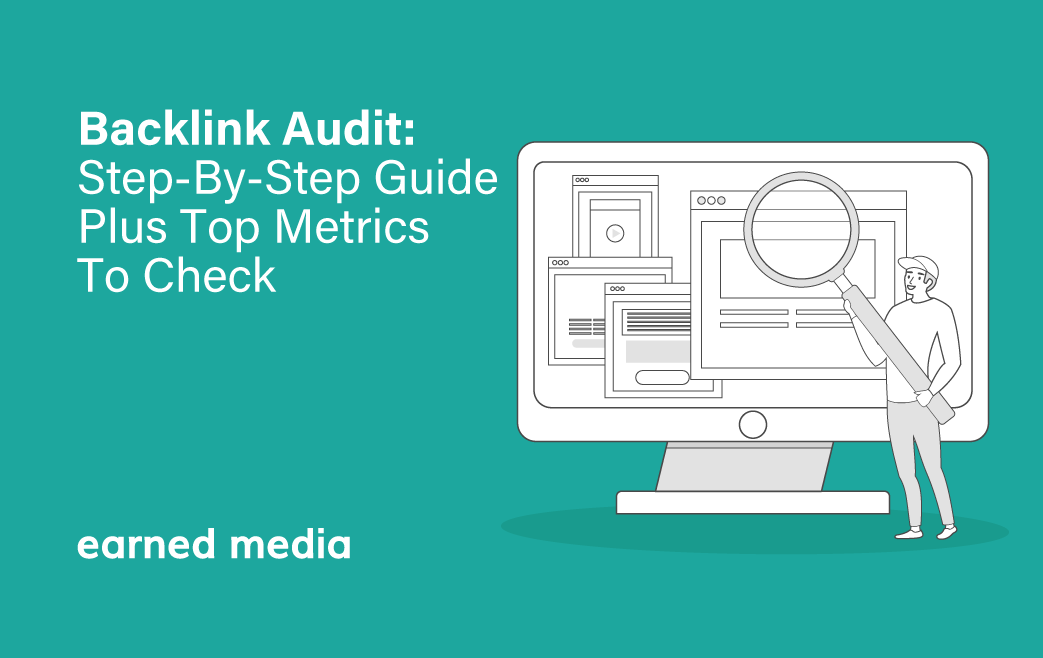
Conducting a comprehensive backlink audit is essential before you begin your SEO campaign because it helps to identify whether the link profile is good or poor. A good link profile means the links pointing to the domain are natural, with fewer chances of Google penalties.
A poor link profile means the links pointing to the domain are unnatural, and the chances of Google penalties are higher. A backlink audit is a significant step to keep your SEO campaigns in check.
This detailed backlink audit guide will help you learn the steps to follow to perform a link audit with the help of various tools. Learn how to evaluate links based on metrics to keep your rankings safe.
A backlink audit is a comprehensive analysis of all the backlinks pointing to your website. The primary purpose of a backlink audit is to identify any potentially harmful or low-quality backlinks that could hurt your website’s rankings.
Once these bad links are identified, you can then take steps to remove or disavow them. Some of the top backlink analysis tools you can use to audit links are Semrush, Link-Assistant, Ahrefs, CognitiveSEO, Majestic, Serpstat, etc.
Related: Learn How To Perform Backlink Quality Checks In Detail
Backlinks are one of the top factors influencing search engine rankings. The number one ranking position page on the SERP has 3.8 times more backlinks than other pages.
But, at the same time, we also can’t ignore the fact that bad or spammy backlinks can negatively impact a website’s SEO score. This is because Google evaluates all sources of links coming to your domain while ranking your website.
If your site has many toxic, low-quality, or spammy backlinks, Google may lower your search engine rankings or even deindex or penalise your site as it violates Google’s Search Essentials.
It is essential to conduct backlink audits to find unnatural or toxic links and remove them to prevent adverse effects on your site’s rankings.
Here are the top advantages of regular backlink audits:
To conduct a backlink audit, you can use a wide range of backlink audit tools such as Semrush, Ahrefs, Moz, or Website SEO Checker. You can also perform individualised manual checks.
Open the Semrush Backlink Analytics tool, enter your website URL, and hit the Analyse button. You will see a complete overview of your backlink profile, as shown in the image below.

You can see various insights, including Authority Score, Referring Domains, Backlinks, and Monthly Visitors.
You can check new and lost referring domains and backlinks on the same page.
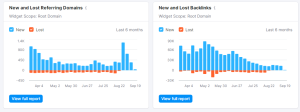
Also, you can see the top categories of the links that point to your domain. To check the complete list of categories, view the full report.
You can see the most popular anchor texts linking to your domain on the right-hand side. The popularity of each anchor is determined by the number of backlinks used.
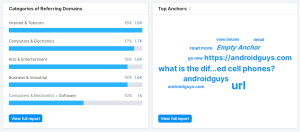
Semrush lets you know the types of backlinks your domains have, like text, image, form, or frame links. You can also check how many links are followed, nofollow, sponsored, and UGC.
Semrush also shows a breakdown of referring domains by their top-level domain type and top countries sending the most backlinks to your domain.

Click on the “Backlinks” tab to see all the backlinks. You can see all links with different metrics like source page and title, the number of links, internal links, anchor text, target URL, and first and last seen of the link.

You also have various filters that help you sort out the backlinks based on your requirements.
Now, you need to export the complete backlink profile to Excel or a CSV file that we will use later in our backlink audit. Click Export > Excel, as shown in the image below, to download all the backlinks.

Search Console can be an excellent alternative if you don’t have the budget to purchase premium tools like Semrush. Visit Google Search Console and open your website property.
Now, navigate to “Links” located at the left sidebar, as shown in the image below.
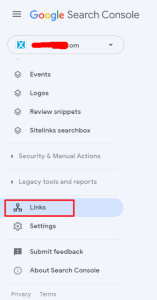
Here, you can see all the link data, like external links, internal links, and top-linking texts. Navigate to “Top linking sites” and click on the “More” button to see the complete report.

Now, you can see the total number of external links pointing to your website and the total number of links coming from each domain.
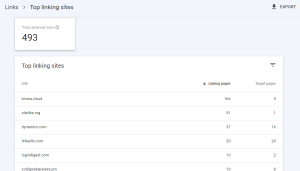
You can click on any domain to see the source and target URL, as shown in the image below.

You can export the list of all external links in Google Sheets, Excel, and CSV from the Search Console.

This helps you compare your link acquisition rate with your competitors.
Also, you can check your referring domains over time and compare them with your competitors. For this purpose, you can visit Semrush’s Backlink Analytics overview and navigate to Referring Domains, as shown in the image below.

Semrush allows you to check the link acquisition rate of the last year, or you can also check all-time data.
As you can see, the website has a rising graph, which means the number of referring domains is increasing. Here, you should check a sudden spike or downfall in the number of referring domains.
Here is a snapshot of the comparison:

Once you have successfully compiled a list of links pointing to your website, the next step is to evaluate every single backlink to identify its quality. Below, you can find a list of metrics you should check for all your backlinks:
Domain Authority (DA) is a barometer that measures the strength of a website’s domain. It is calculated by evaluating various factors, including link equity, age, and popularity.
Visit Moz Link Explorer and enter the website URL to get the Domain Authority, as shown in the image below.
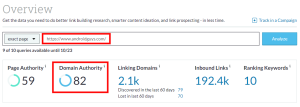
Instead of checking the DA of each link manually one by one, you can use a bulk DA checker to check unlimited links at once.
Like Moz’s DA, there is DR (Domain Rating), a website quality check metric. You can check it using the Ahrefs Website Authority Checker, as shown below.
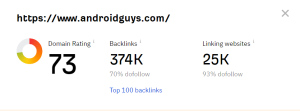
Quality sites have higher DA and DR. You should check all the domains pointing to your site as downloaded in the first step. You can use the bulk DA checker tool to check the DA of several domains at once.
Page Authority (PA) or URL Rating (Ahrefs) indicates the authority of the actual link page (from which your domain receives a link) as opposed to the domain URL.
A higher PA or URL Rating means that the page is of high quality regarding rankings on the search results. Similar to DA, you can use Moz Link Explorer to find PA, as shown in the image below.
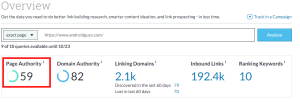
You should check the Page Authority (PA) of all your links.
Referring domains are the domains that link to your website. Websites with more referring domains mean that the site has high authority and ranking capabilities.
Check the number of referring domains your links have. It would be best to double-check the links from the sites with few referring domains.
The spam score is another important metric that helps evaluate backlinks. It can be checked using the Moz tool. Enter the website URL and go to the Spam Score option on the left sidebar, as shown in the image below.
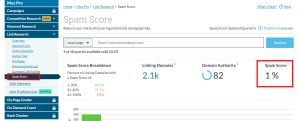
As you can see, Moz also shows the overall spam score breakdown and a chart showing the number of linking domains on a scale of 1% to 100%.

You can also find a list of backlinks sorted based on spam score on the same page.

You can filter links with a spam score of over 5% to 10% and keep them in an Excel file for further action. You can use bulk spam score checkers like Website SEO Checker to save time.
Related: Reputation Management: 6 Tips To Protect Your Brand
You can also check the organic keywords of your backlinks’ domain because any site linking to your domain ranks for many keywords, meaning those domains are high quality. You can check this data using Semrush. Click on the down arrow to any domain (under Semrush Backlink Analytics) and see the “Keywords” as shown in the image below.

Acquiring links from websites with a lot of search traffic is more valuable. You can check traffic to a site using a tool like Similar Web:
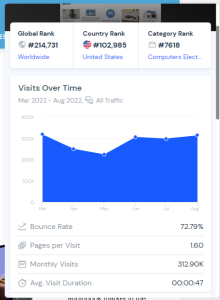
Similarweb also shows the traffic breakdown by country.
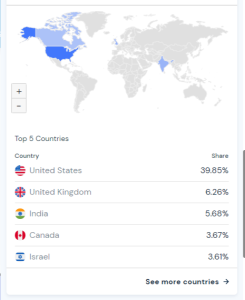
You can also check the breakdown of traffic by sources like organic, direct, social, referrals, email, and display ads.
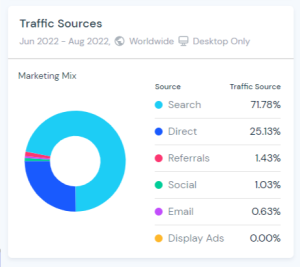
It doesn’t matter which link building method you use to acquire links to your website; the website must be relevant to the targeted page you are trying to get a link from. For example, if you have a real estate website that provides services to customers, a link from a real estate blog is much more valuable than a link from a health blog.
Related: 12 Best Link Building Strategies To Inspire Your Next Campaign
A site search can also be very helpful in the backlink audit process as it helps you sort out spammy websites. It is also important because sometimes spammy links have not been uncovered in the above tests. For example, a site with a good DA, PA, and spam score can also be spammy.
You can use the Google search operator to identify spammy links. Here are a few searches that are recommended for the site search analysis process:
Now, let’s see how this process works. For example, Online News Buzz has the following metrics:
As you can see, this website passes every metric, but when we did the site search analysis, we found that the site is publishing content on casino topics. Here are some screenshots:
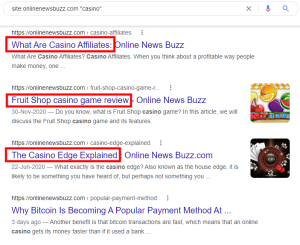
Avoid links from such websites unless you promote a casino website. You can also check if you suspect a low-quality news site might be a private blog network (PBN) and check if they have an active social media profile. If they do not, then this could be another red flag.
Related: E-commerce SEO: Strategy, Best Practices, Tools, Solutions
It doesn’t make sense if you have links from languages other than your website language. For example, if your site is in English, but you have links from German, French, or other languages.
These types of links can be potentially harmful to website SEO. To identify such links, you can also use Semrush. Enter your domain in the Backlink Analytics tool and see the TLD Distribution report, as shown in the image below.

Now, click on backlinks and check every link you receive from other languages.
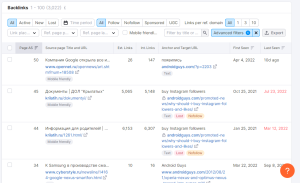
Analysing your anchor text profile is a great way to find spammy backlinks. When you do this, you’ll notice that genuine sources usually link to your website using your brand name or keywords relevant to the context.
To check your anchor text profile, click on Anchors in Semrush Backlink Analytics to see the complete list of anchor texts used in links.
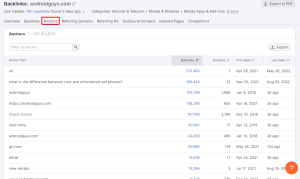
As you can see, Android Guys have a clean anchor profile. It would be best if you looked for unnatural and over-optimised anchor texts.
Related: Content Marketing: Definition, Strategies, Tools, Examples
It takes work to check thousands of links one by one. Hence, finding the worst sites that link to your domain is better. You can use Semrush to find a list of spammy sites quickly.
Here is how you can check:
First, enter your domain in Backlink Analytics and click on ‘Analyse.’

Now, navigate to Backlinks and click on Page AS to sort out the low authority links at the top, as shown in the below image.

Once you sort the links from lower to higher authority, you can see all the poor links, as shown in the image below.
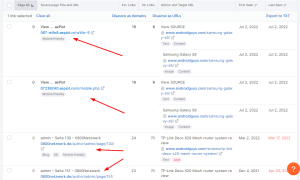
Related: SEO Copywriting: Definition, Strategies, Benefits, Tools
It is also one of the best ways to evaluate links. In this method, you check and try to find links coming from different referring domains but with the same IP address.
To check links from the same IPs, navigate to Referring IPs and check which IP most of the links are coming to your domain.
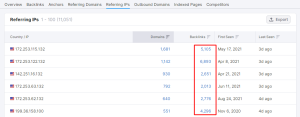
As shown in the above image, we have multiple IPs with thousands of referring domains and backlinks. If you open any of these IPs, you will see all the links coming from the same IPs.
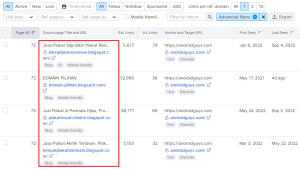
You should check links from the same IPs because too many can negatively affect your website’s SEO.
Related: Enterprise SEO: Tactics, Tools, Statistics, Examples, Solutions
Another critical aspect of a backlink audit is to find broken links on your website. There might be pages on your site with links to them, but those pages now return a 404.
We can find such pages using Semrush. Go to Backlink Analytics > Indexed Pages and select Broken Pages, as shown in the image below.
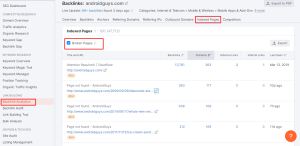
As you can see, Android Guys have several broken pages with many backlinks. You can also sort the results by the highest backlinks.
Once done, pick broken pages and see all the backlinks pointing to them. For example, one of the broken pages has 98 backlinks. You should 301 all such links to relevant pages.

Related: Editorial Links: 9 Ways To Crush Your Link Building Campaign
When you have identified a list of low-quality, toxic, or spammy links, it’s time to clean up your backlink profile. For doing this, we have two options, i.e., manual removal and disavowing.
Under the link removal method, you should contact the owner of the websites that don’t qualify for the above link evaluation tests and request them to remove your link. Here is an example link removal email template you can use to message web admins:
Hi [Name],
I am trying to remove some backlinks pointing to my website, [Your Website URL].
I would appreciate your help in removing these links.
Here are the links that I would like to remove:
Link: [Page URL where the toxic link exists]
Anchor: [Add the anchor text]
If you could please send a confirmation letting me know that the links have been removed, I would appreciate it.
Thanks in advance! I hope to hear from you soon.
Cheers,
Your name
In some cases where the website owner can’t be reached, you can disavow those links. Disavowing a link means telling Google not to consider those links while ranking your website on the SERP.
To disavow links, you have to use the Google Disavow Tool. Open the tool and select your property from the drop-down list, as shown in the image below.

Now, you need to prepare the links to disavow file where you have to list down all the spammy links you would like to disavow. But, the disavow file needs to be in the proper format provided by Google here.
Here is what it looks like:
# Two pages to disavow
http://spam.example.com/stuff/comments.html
http://spam.example.com/stuff/paid-links.html
# One domain to disavow
domain:shadyseo.com
Once the disavow file is prepared, you must upload it to the tool, as shown in the image below. Note that Google may take a few weeks to process the request.

Caution: Before uploading the file, double-check every single link so you don’t disavow any quality links by mistake. Disavowing toxic links should only be done when you suspect unnatural links, for example, bad backlinks that contain an unnatural anchor text distribution using rich anchor text keywords or that go against Google’s Webmaster guidelines (e.g., paid links, link schemes, etc.).
Related: Digital PR: Definition, Strategies, Examples, Tools, Solutions

Nick Brogden leads the company as Founder and CEO of Earned Media, acting as Chief SEO Strategist and primary client contact. Nick provides clients with personalised and expert SEO guidance that aligns with the industry’s best practices and has over 12 years of hands-on SEO experience. Have any SEO questions you’d like to ask Nick? Drop him an email at nick@earnedmedia.com.au.

Nick Brogden leads the company as Founder and CEO of Earned Media, acting as Chief SEO Strategist and primary client contact. Nick provides clients with personalised and expert SEO guidance that aligns with the industry’s best practices and has over 12 years of hands-on SEO experience. Have any SEO questions you’d like to ask Nick? Drop him an email at nick@earnedmedia.com.au.
Our experts continually monitor the SEO space, and we update our articles when new information becomes available.
Earned Media is an SEO agency specialising in technical SEO, link building, and content. We focus on ethical SEO strategies that drive mouthwatering, delicious results.

 18 min
18 minDiscover how to develop and boost organic traffic and establish a robust link profile with these eCommerce link building strategies.

 16 min
16 minWhen a PR tool becomes mainstream, competition to get editorial links increases. Here’s how HARO link building works and 8 alternatives you could use.

 13 min
13 minThis detailed backlink audit guide will help you learn the steps to follow to perform a link audit. Learn how to evaluate links and safeguard your rankings.

 13 min
13 minSelecting an SEO agency can be tough and stressful. These 15 questions will help you decide if an agency could be a good or bad fit.

 25 min
25 minLearn the best white strategies we use here at Earned Media that you could consider implementing in your SEO campaign.
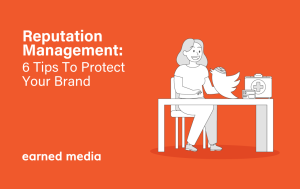
 12 min
12 min67.7% of consumers report that positive or negative reviews impact purchasing decisions. Here’s what you need to know about protecting your brand’s image.

 19 min
19 minEditorial links are incredibly valuable backlinks to get. Learn what an editorial link plus 9 ways to get them in this detailed step-by-step guide.

 72 min
72 minLink building is integral to every SEO strategy, and can improve your website’s rankings. Go from beginner to advanced in this guide.

 20 min
20 minA technical SEO audit can also give you insight into your competitor’s websites to see what is and isn’t working. Find out everything you need to know.

 20 min
20 minE-commerce SEO helps online stores rank higher in search engines, increasing traffic, sales and visibility. View examples, tools, strategies, and solutions.

 18 min
18 minContent marketing is a crucial part of any successful SEO campaign. This guide will show you what content marketing is, how it works, and why you need it.

 17 min
17 minEnterprise SEO is critical for large businesses. It drives digital strategies aligned with organisational goals. Learn about the benefits of enterprise SEO.

 18 min
18 minSEO copywriting is the art of writing search engine-friendly content for search engines and users alike to improve organic search rankings.

 18 min
18 minDigital PR is a contemporary twist on traditional PR and communications. It promotes products and services and influences public opinion and perception

 17 min
17 minOne critical element for all digital marketing campaigns is SEO. Finding a professional SEO company is challenging. This guide will help you do just that.

 6 min
6 minThe primary purpose of a website is to offer the best user experience. Here are five website design mistakes that can hurt your SEO.

 8 min
8 minContent marketing remains one of the most cost-effective channels of digital marketing with 72% of marketers agreeing that it increases engagement.

 7 min
7 minAn effective digital branding strategy provides fantastic opportunities to power past the competition. Here are 5 things to consider.

 8 min
8 minGoogle Page Experience is a measure of how the users are interacting with your website. A website’s organic rankings may drop until you fix these issues.

 8 min
8 minA guest post strategy helps brands acquire tons of relevant and high-authority links. Here is how you can get started with guest posting.

 7 min
7 minApply the power of copywriting to make your title tags more appealing to searchers. Keep it human, and traffic will start flowing to your site.
